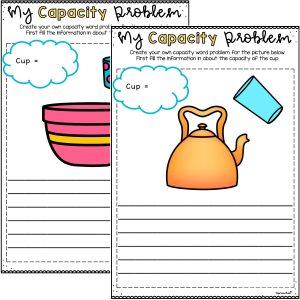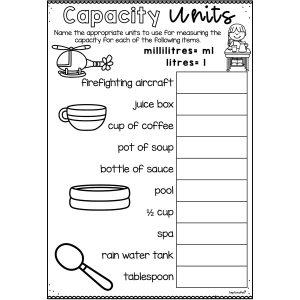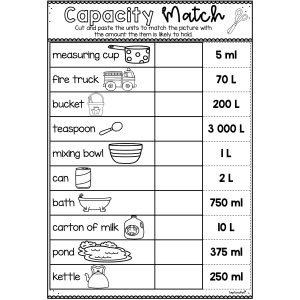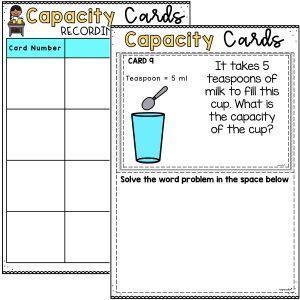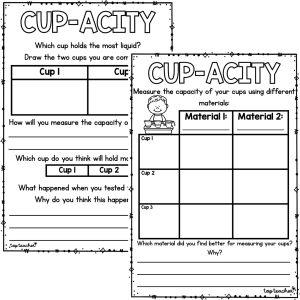Capacity Challenges

Description
Help your students deepen their understanding of capacity with our visually engaging and differentiated Capacity Challenges worksheets. Designed to stretch students' thinking and encourage real-world application of measurement concepts, this activity blends visual prompts with tiered questions to suit a range of learners.
Each worksheet features a detailed picture related to capacity – from kitchen scenes to outdoor play – and asks students to interpret the image to answer a series of capacity-based questions. These aren’t just quick answers – students are encouraged to estimate, compare, reason, and explain their thinking as they explore the contents and relationships within the picture.
With two different image scenes and three levels of questions for each, this resource provides built-in differentiation. Whether your students are still consolidating basic understanding or ready to engage in higher-order reasoning, there’s something here to support and challenge them. The variety of question levels makes this an ideal resource for mixed-ability groups or individual goal-based work.
Key Learning Outcomes:
- ✅ Estimate and compare the capacity of different containers
- ✅ Identify which objects hold more or less based on visual cues
- ✅ Apply mathematical vocabulary like ‘full’, ‘empty’, ‘litres’, and ‘millilitres’
- ✅ Justify reasoning using measurement language and strategies
- ✅ Strengthen comprehension and data interpretation skills through visual analysis
What’s Included:
- Two capacity-themed illustrated scenes
- Three levels of questions per image – progressing in complexity
- Colour and black & white versions for flexible printing
- Answer sheets included for easy marking or student self-checking
Materials Needed:
- Printed worksheets (in colour or black & white)
- Pencils or pens for student responses
- Optional: mini whiteboards for discussion and brainstorming
- Optional: laminated copies for use with whiteboard markers in rotations
How to Use:
- Introduce key capacity language and visual clues with a class discussion
- Provide each student or group with a worksheet and matching question set
- Students examine the image and respond to each question levelled to their needs
- Use the answer sheets to review responses together or support peer marking
- Display completed responses to celebrate different problem-solving strategies
Ideas for Classroom Use:
- 💡 Use in maths rotations to target different levels of capacity understanding
- 💡 Project one image on the board and answer as a class for guided discussion
- 💡 Print two levels of questions and let students choose their challenge level
- 💡 Use for formative assessment at the end of a capacity unit
- 💡 Follow up by asking students to create their own picture and capacity questions
Top Teacher Tips:
- 💛 Provide sentence stems like “I think this holds more because…” to support written responses
- 💛 Laminate the coloured scenes for reuse year after year
- 💛 Use the lower-level questions with physical containers as a hands-on extension
Capacity Challenges turns everyday objects into a springboard for mathematical reasoning – helping students think deeply, use key vocabulary and connect visual cues with measurement knowledge in an engaging, meaningful way.
Additional information
| Australian Curriculum Code | AC9M2M01, AC9M3M01, AC9M3M02 |
|---|---|
| File Format |
Australian Curriculum V9
F - 6
Lorem ipsum dolor sit amet, consectetur adipiscing elit.
Lorem ipsum dolor sit amet, consectetur adipiscing elit.
Lorem ipsum/ Lorem ipsum/ Lorem ipsum
Lorem ipsum dolor sit amet, consectetur adipiscing elit.
Lorem ipsum dolor sit amet, consectetur adipiscing elit.
Lorem ipsum/ Lorem ipsum/ Lorem ipsum
Lorem ipsum dolor sit amet, consectetur adipiscing elit.
Lorem ipsum dolor sit amet, consectetur adipiscing elit.
Lorem ipsum/ Lorem ipsum/ Lorem ipsum
Lorem ipsum dolor sit amet, consectetur adipiscing elit.
Lorem ipsum dolor sit amet, consectetur adipiscing elit.
Lorem ipsum/ Lorem ipsum/ Lorem ipsum
Lorem ipsum dolor sit amet, consectetur adipiscing elit.
Lorem ipsum dolor sit amet, consectetur adipiscing elit.
Lorem ipsum/ Lorem ipsum/ Lorem ipsum
